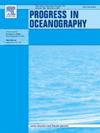Seasonal variations and biological regulation of deep-sea CO2 species in the Eastern Indian Ocean
IF 3.6
3区 地球科学
Q1 OCEANOGRAPHY
引用次数: 0
Abstract
The ocean absorbs anthropogenic CO2 and sequesters it in deep water through the marine biological pump, playing an irreplaceable role in global climate change. This study investigates the vertical distribution of CO2 system parameters in the deep Eastern Indian Ocean during autumn 2020 and spring 2021. Additionally, the role of biological processes in regulating the CO2 system parameters were examined via incubation experiments. Results showed that dissolved inorganic carbon (DIC) and alkalinity concentrations were higher in deep layers compared to those in upper layers. pH decreased initially and then increased with depth, while the partial pressure of CO2 followed an opposite trend to pH in both seasons. Overall, DIC concentration was higher, while dissolved organic carbon concentration and δ13C-DIC value were lower in the water column during spring 2021 than autumn 2020, indicating strong respiration during spring 2021. The surface seawater DIC absorption rates during autumn 2020 followed the sequence: St. 1 > St. 4 > St. 2, while the Chl-a increasing rates were: St. 1 > St. 2 > St. 4. The discrepancy indicated the relatively low production at St. 2 and high photosynthetic efficiency at St. 4, which was dependent on the light, phytoplankton composition and abundance. The DIC production rates declined with depth during spring 2021, which was controlled by temperature. The integrated-average rates in the water column followed the sequence: St. 8 > St. 6 > St. 5 > St. 7, heavily relying on microorganism species and abundance, which revealed that respiration processes in the aphotic layer also played important roles in regulating DIC variations and the carbon cycling in the ocean.
东印度洋深海CO2物种的季节变化和生物调控
海洋通过海洋生物泵吸收人为排放的二氧化碳并将其封存在深水中,在全球气候变化中发挥着不可替代的作用。本文研究了2020年秋季和2021年春季东印度洋深海CO2系统参数的垂直分布。此外,通过培养实验研究了生物过程在调节CO2系统参数中的作用。结果表明,深层溶解无机碳(DIC)和碱度浓度高于表层。随着深度的增加,pH先降低后升高,CO2分压与pH呈相反趋势。总体而言,2021年春季水体中DIC浓度较高,溶解有机碳浓度和δ13C-DIC值较2020年秋季低,说明2021年春季水体呼吸作用较强。2020年秋季表层海水DIC吸收率依次为:St. 1 >;St. 4 >;St. 2,而Chl-a的增长率为:St. 1 >;圣2 >;圣4。这一差异表明St. 2的产量相对较低,而St. 4的光合效率较高,这取决于光照、浮游植物组成和丰度。在2021年春季,DIC产量随深度下降,这受温度控制。水柱的综合平均速率顺序为:St. 8 >;St. 6 >;圣5 >;St. 7,高度依赖于微生物种类和丰度,这表明无氧层的呼吸过程在调节海洋DIC变化和碳循环中也起着重要作用。
本文章由计算机程序翻译,如有差异,请以英文原文为准。
求助全文
约1分钟内获得全文
求助全文
来源期刊

Progress in Oceanography
地学-海洋学
CiteScore
7.20
自引率
4.90%
发文量
138
审稿时长
3 months
期刊介绍:
Progress in Oceanography publishes the longer, more comprehensive papers that most oceanographers feel are necessary, on occasion, to do justice to their work. Contributions are generally either a review of an aspect of oceanography or a treatise on an expanding oceanographic subject. The articles cover the entire spectrum of disciplines within the science of oceanography. Occasionally volumes are devoted to collections of papers and conference proceedings of exceptional interest. Essential reading for all oceanographers.
 求助内容:
求助内容: 应助结果提醒方式:
应助结果提醒方式:


